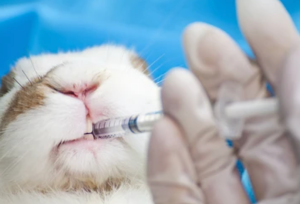8 Diagnosis and Treatment of RGIS (Let’s Make That Bunny Feel Better!)
Diagnosis
If we want to help the bunny, we have to figure out what might be causing the RGIS!
Here are a few things we can do to get some answers…
1. Take a medical history (Has anything stressful happened lately? When did the owner notice these symptoms?)
2. Take x-rays of the bunny
3. Run some blood work
4. Test the poop for parasites
5. Test the urine for signs of infection or urinary crystals
6.Urinalysis
7. Toxicology sampling, like blood lead levels (to see if the rabbit ate something poisonous)
10. Ultrasound
11. CT imaging
Treatment

Treatment focuses on four main areas:
- Fluid therapy
- Nutritional support
- Pain relief/promotility medication
- Management of any underlying diseases or causes
Fluid Therapy – Main ways to deliver fluids are by mouth, subcutaneous injection (fluid under the skin), or IV (sending fluid straight into the veins), depending on the increase of severity of dehydration respectively.
Nutritional Support – Instituted ASAP to promote motility and prevent hepatic lipidosis. We usually use a slurry of finely chopped hay and water (a common product is Critical Care by Oxbow) and feed it to the rabbit through a syringe.
Pain Relief/Promotility Medication – Pain and a non-motile gastrointestinal tract exacerbate each other to complicate RGIS.
Use lidocaine intravenously for both pain and motility.
Motility enhancers like metoclopramide and cisapride are routinely used, but may not have any real effects on the rabbit gastrointestinal system.
Underlying Disease – Treat as indicated for the specific disease syndrome.

